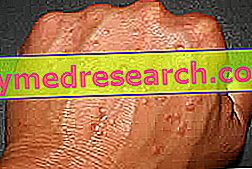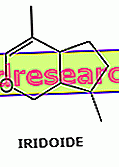Generality
The annular granuloma is a skin disease of an inflammatory nature, which causes the appearance of small detected skin lesions, arranged in a ring or semicircle.

Figure: Generalized annular granuloma.
It is a benign and rather frequent pathology, the cause of which is unknown; however, since it resembles certain autoimmune diseases, it is suspected to have an origin very similar to the latter.
Apart from the cutaneous signs characterized by the typical circular formations, the annular granulomas are often asymptomatic (they do not cause pain and at most there is a slight itching).
For a correct diagnosis, a skin biopsy is required.
Regarding the treatment, in general, the spontaneous resolution of the lesions is expected. In fact, the use of medical care is reserved only for the most serious cases or in the presence of an aesthetic discomfort on the part of the patient.
What is annular granuloma?
The annular granuloma is a skin disease characterized by the appearance, on the skin, of reddish-pink protuberances (also called papules or lesions ) and arranged in a ring or semicircle.
What is a granuloma?
In medicine, a granuloma is a neoformation of an inflammatory nature, of a proliferative and nodular nature, consisting of granulation tissue (NB: the following cells are present in the granulation tissue: monocytes, lymphocytes, plasma cells, histiocytes, macrophages, etc.).
IMMUNE SYSTEM AND AUTOIMMUNE PATHOLOGIES
The immune system is the defensive barrier of an organism against threats from the external environment, such as viruses, bacteria, parasites etc., but also from within, such as "crazed" (tumor) or malfunctioning cells.
The immune system is made up of an "army" of very effective and very aggressive cells and glycoproteins against those who represent a potential danger.
In some individuals, very often for unknown and unclear reasons, the immune system undergoes an alteration that causes it to attack some perfectly healthy cells in the body, attacking them. All this can lead to damage, sometimes very serious, to different organs and tissues of the body.
It is this abnormal behavior of the immune system that distinguishes the so-called autoimmune diseases.
TYPES OF ANULAR GRANULOMA
Based on the characteristics with which it occurs, the annular granuloma can be distinguished in the following forms (or types):
- Localized annular granuloma
- Generalized annular granuloma
- Annular granuloma of the speckled type
- Subcutaneous annular granuloma
- Perforating annular granuloma
- Annular granuloma typical of HIV infections (AIDS)
Epidemiology
It is believed that the annular granuloma is a fairly common morbid condition, however precise data regarding the real incidence and prevalence are not available.
It has been established that the most affected subjects are young and adult people (around 30 years of age) and that the female sex is more interested than the male one.
The most common annular granuloma is the localized form, which characterizes about ¾ of the cases.
The second most common type of annular granuloma is the generalized one (10-15% of cases).
The most observed form in children is the subcutaneous annular granuloma : the affected subjects generally have between 2 and 5 years.
Finally, the least common type of annular granuloma is the perforating type, which can affect both young and adults.
Causes
The precise causes of annular granuloma remain, at the moment, unknown.
As many patients with annular granuloma are also affected by diabetes, thyroid disorders, tumors, hyperlipidemia or by some autoimmune disease (in particular systemic lupus erythematosus, Addison's disease and rheumatoid arthritis ), some researchers have suggested that there may be a causal correlation between these pathological conditions just mentioned and the annular granuloma itself.
However, doubts about this hypothesis arise in the presence of those patients who, except for the annular granuloma, are completely healthy.
OTHER THEORIES
According to some minor theories, annular granuloma would be the consequence of an allergic reaction to gluten, copper or tetanus vaccine; according to others, it would be the body's response to a bone fracture.
Symptoms and Complications
To learn more: Annular Granuloma Symptoms
With the exception of the protuberances on the skin, the annular granuloma is usually asymptomatic (ie the patient does not complain of symptoms). In the few cases in which it causes disorders, these are limited to a sensation of itching and / or burning.
Each type of annular granuloma has very particular and distinctive characteristics. Below is a brief description of the main forms and relative clinical picture.
LOCALIZED ANULAR GRANULOMA
The localized annular granuloma manifests itself with the appearance of papules approximately 1-2 millimeters in diameter and pink-red in color ( erythema ). These papules tend to be arched or to form a real ring with a diameter between one and 5 centimeters.
The center of the annular formations is generally depressed, so that the appearance of the areas concerned is very reminiscent of the craters of volcanoes.
Sometimes it is possible for the most central portion of the rings to show hyperpigmentation.
The most affected anatomical areas are the hands, feet, fingers and extensor surfaces of legs and arms (NB: the term extensor compared to a limb refers to the part of the limb in which the muscles that allow the 'extension).
GENERALIZED ANULAR GRANULOMA
The generalized annular granuloma could be mistaken for the localized type, except that the papules are more numerous and, often, a cause for burning and itching .
The typical annular formations can have a variable diameter between 3 and 6 centimeters; before reaching their final size, it can take up to several weeks or months.
The most affected anatomical areas are the limbs and the trunk.
SUBCUTANEAN ANULAR GRANULOMA
Unlike other types of annular granuloma, the subcutaneous annular granuloma is characterized by lesions located in the innermost layers of the skin.
The affected areas are generally the same color as the rest of the skin and appear with a rigid consistency. More than papules, in fact, we speak of nodules.
In most cases, nodular formations are solitary, although, in some patients, they may occur in small groups.
The areas of the body most affected are the lower parts of the legs, in particular the surfaces of the shins.
PERFORATING ANULAR GRANULOMA
The perforating annular granuloma generally presents with pink-red papules and a diameter varying between 1 and 4 millimeters.
The papules can be isolated or extremely crowded together, forming a sort of ring-shaped plaque. Very often papules cause itching and pain.
Furthermore, once they have disappeared, skin lesions tend to leave a hyperpigmented or hypopigmented scar in the area where they were located.
The most affected anatomical areas are the lower parts of the legs, the extensor surfaces of the arms and the back of the hands.
WHEN TO REFER TO THE DOCTOR
If papules of the type just described and other particular cutaneous signs do not hint to heal spontaneously within a few weeks, it is always good to contact your doctor for a thorough investigation of the situation.
COMPLICATIONS
The annular granuloma does not cause particular complications. The only drawbacks to report to him are:
- The aesthetic discomfort created (for example by the generalized type).
- The slow healing, which could sometimes happen after several years.
- When the lesions are itchy, the possibility that the papules become infected by scratching.
Diagnosis
To diagnose an annular granuloma, the doctor uses a physical examination, followed by a laboratory analysis on a sample of skin cells (skin biopsy).
EXAMINATION OBJECTIVE
During the physical examination, the doctor observes the skin signs and assesses their consistency. After that, he asks the patient what symptoms he feels (burning, itching, etc.), how long the papules have formed and whether he is suffering from other diseases.
CUTANEOUS BIOPSY
The skin biopsy consists of the collection and subsequent analysis, in the laboratory, of a small sample of skin cells taken from one or more lesions.
Pathologies that can be mistaken for an annular granuloma and that the skin biopsy allows to exclude (differential diagnosis):
- Psoriasis
- Sarcoidosis
- Leprosy
- Nummular eczema
- Chronic migrant erythema
- Pityriasis rosea
- Tinea corporis (or ringworm)
- Rheumatoid nodules
In the case of annular granuloma, these cells have a characteristic and unequivocal histological (or tissue) composition; for this reason the bioptic test is the most reliable diagnostic test currently available.
Treatment
In most cases, the annular granuloma heals spontaneously without special treatment.
If you resort to drugs or special therapies, it is only for aesthetic reasons and / or to try to accelerate recovery.
Corticosteroid preparations are the main treatments; to follow, could be useful: cryotherapy, laser ablation, some immunosuppressive drugs etc.
Unfortunately, for many patients, the treatments available are not very effective: the results, in fact, are often not very noticeable.
CORTICOSTEROIDS FOR TOPICAL OR LOCAL USE
Corticosteroids are powerful anti-inflammatory drugs belonging to the steroid family. For topical use, it is understood that the preparation, in the form of cream or ointment, is applied directly to the affected area.
Topical corticosteroids are intended to improve the appearance of lesions and speed healing.
In the event of prolonged use, they can cause various side effects, including: acne, increased hair growth, spider veins and thinning of the skin.
Topical corticosteroids are particularly indicated for localized annular granulomas.
CORTICOSTEROIDS THROUGH INJECTION
Corticosteroids can also be administered by injection . The inoculation site is, of course, the area in which the papules reside.
The reasons that lead doctors to resort to this therapeutic method are the presence of burning, itching and large annular formations.
OTHER TREATMENTS
As an alternative to corticosteroids, in some patients they also appear to have discrete effects:
- Immunosuppressive drugs . These drugs lower the patient's immune defenses, also reducing the abnormal inflammatory reaction caused by a malfunctioning immune system. This action is useful above all when other autoimmune diseases are associated with the annular granuloma.
- Oral corticosteroids . They are used above all in the case of generalized annular granuloma. If taken in high doses and / or for long periods, they can cause serious side effects, such as osteoporosis, hypertension, increased body weight, cataracts, diabetes etc.
- Cryotherapy with liquid nitrogen . Promotes the removal of lesions on the skin and stimulates the growth of new skin. It is indicated in the case of small annular formations (for example in the presence of localized annular granuloma).
- Laser ablation . Helps improve the appearance of lesions on the skin.
- Psoralen followed by UV exposure (PUVA) . This treatment serves to improve the appearance of lesions on the skin. Psoralen is a drug that increases skin sensitivity and is given to the patient before exposure to UV rays.
- Antibiotics . Used in combination with each other, preparations such as minocycline, rifampicin and ofloxacin seem to have some positive effects in accelerating healing. However, in some subjects they are completely ineffective.
Prognosis
In almost half of the cases, the localized form (which is also the most common) heals after two years and may reappear some time after resolution.
The generalized type can have an even slower course: for some patients, the disappearance of the annular formations can occur even after 10 years. Furthermore, the response to treatments is not always satisfactory.
Subcutaneous annular granulomas resolve very often spontaneously, but are at high risk of recurrence.
Therefore, the prognosis depends on the type of annular granuloma and how the patient responds to treatments.



